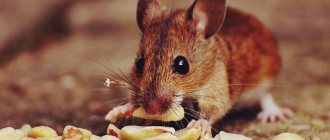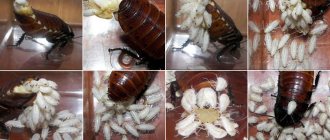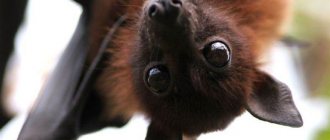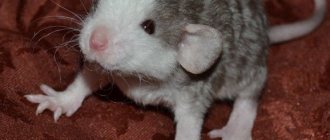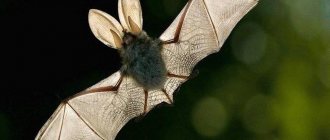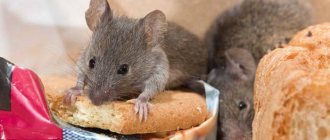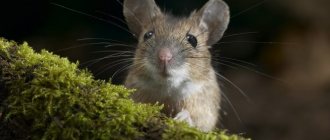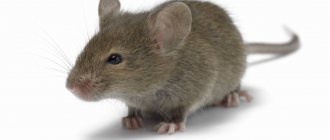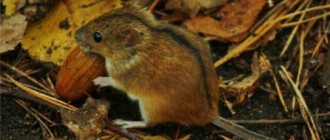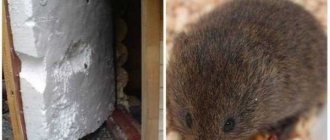Not only breeders, but also rodent fighters need to know how mice reproduce and how long they live. Cute domestic animals and terrifying street dwellers, under favorable conditions, are able to reproduce all year round.
Only at sub-zero temperatures does the female stop estrus and the males are not interested in her. An individual gives birth to about 10 cubs at a time, and the next litter may appear 1-2 months after the previous one.
During this period, the babies grow up and are able to become fertilized themselves.
Birth and development of pups in mice
Pregnancy in house mice lasts on average 22 days (20-26 days) and it proceeds easily and without complications.
Typically, in mice, the fetuses in the uterus are located with their heads towards the exit of the uterus and there is no pathology of birth, and cases of death from childbirth among mice are very rare. Childbirth usually occurs at night. One litter usually contains from five to nine mice. It is interesting that just a day after giving birth, the female comes into estrus and is again ready for mating and can become pregnant again. In females, lactation and pregnancy can sometimes occur simultaneously. Therefore, almost every female house mouse can give birth to up to 10-11 litters in a row. But such intensity of reproduction greatly exhausts it. For this reason, to obtain good offspring, no more than nine litters are allowed.
In normally kept female mice, stillborn pups are quite rare. The reason for this may be a lack of vitamins and microelements in the feed, as well as some infections. But baby mice that were born normal sometimes die soon after birth due to some reason. This may be the lack of milk in the female, an underdeveloped instinct of motherhood, or stress, due to which the female tries to hide the mice, dragging them around the cage, as a result of which they die. Sometimes it happens that pups are born underdeveloped, as they were stunted in growth during the embryonic period, which is most often associated with insufficient and poor-quality nutrition of the female during pregnancy.
Since such pups, as a rule, die, the birth of weak litters serves as a signal of problems associated with the diet or feeding of the animals. But the death of offspring during closely related breeding of mice is almost never observed. Sometimes mice may be born smaller than normal, but, as a rule, they quickly gain the required body weight.
Mice are born naked and with their eyes and ears closed. On average, the weight of newborn mice is about 1-2 g, with a body length of about 3 cm. The mice are born helpless and practically do not move. In newborn mice, determine the sex, i.e. It is almost impossible to distinguish females and males. But at a later age, males become larger than females.
During this period, it is necessary to maintain high milk production of the female. There should always be good quality milk and fresh water in the cage. Newborns grow quickly. Their mass doubles on the fourth or fifth day, and the linear dimensions of the body increase. On the third to fifth day after birth, the baby mice's ears open and their bodies begin to become covered with hair. The first teeth - the lower incisors - erupt on the eighth day, and the upper ones - on the 14th day after birth. At two weeks of age, the mice's eyes open and they begin to see the world around them. The pups emerge from the nest around the third week of life and from that time begin to consume food on their own. The weight of mice at this age averages about 8-8.3 g.
Soon after this, on the 20-25th day after birth, the young animals are weaned from females and mother's milk. At the same time, if the female is lactation and pregnant at the same time at this time, then the young animals should be weaned at least a day or two earlier than the stated period. And immediately during jigging, it is advisable to seat the males and females in different cages to avoid their mating. And after weaning from mother's milk, the pups continue to grow rapidly, reaching 11-12 g by the age of one month, depending on gender, their body length is about 6 cm, and their tail is about 5 cm. And only by six to seven months in whites mice complete their growth and development and stabilization of body weight and linear dimensions occurs. By this time, young house mice already weigh about 25-30 g. In the future, the body weight of adult mice may change depending on the quantitative and qualitative indicators of feeding and also depend on the conditions of keeping the mice.
Offspring
The health of the offspring depends on the quality of the female’s nutrition during pregnancy and the interval between matings. At birth, babies do not see or hear anything, they have no fur, but they have a good appetite. Each weighs no more than 1.5 g.
After a week, you can see grown hair on the animals’ bodies, and the first incisors of the lower jaw appear in the mouth. By 14 days of age, a baby mouse can already see and hear.
Females have noticeable nipples from childhood. In males, the testicles move from the abdominal cavity to the scrotum only in the second week. It is after this that the gender of the offspring can be understood.
A wild litter is not the same as that of a domestic mouse. It develops faster. If indoor rodents are picked up prematurely, the mother may abandon them.
Therefore, offspring can be accustomed to human attention after three weeks, when rodents leave the nest in search of new horizons.
Month-old indoor animals can be given to other people for new families. At this age, they are unlikely to eat their mother's milk. And they switch to adult food and become completely independent.
Video
The mouse has given birth! What to do ?
Physiological abilities
In the wild, the process of pregnancy and birth is regulated independently and directly depends on climatic conditions and the availability of food. At home, a lot depends on the person.
The mouse becomes sexually mature at the age of 30 to 50 days, depending on the variety and living conditions. However, the final formation of the animal ends by 12 months. Early fertilization can cause significant harm to the body, and the animal runs the risk of dying during childbirth.
It is allowed to mate a domestic mouse at 6 months; in nature, this moment occurs a little earlier. In a year, a female can reproduce up to 8 offspring. But this rarely happens, for several reasons.
- In nature, mice reproduction ends with the onset of cold weather.
- At home, pregnancy is controlled by a person.
On average, one mouse gives birth 4 times per year. The ability to fertilize appears 14 hours after birth. The estrus period lasts 18 hours. The entire mating season is very fast - 5 days.
Mating and pregnancy in rodents
Description of the rodent
Animals of this species are very tiny compared to rats. The body of an adult mouse reaches only 6.5-9.5 cm in length. The tail of a rodent is almost half as long as the body. It is covered with scales and small sparse hairs.
The average weight of an adult is only 12 to 30 grams. The ears are small and rounded. The color is predominantly dark, brownish-gray. On the belly, the fur is lighter and colored ash-gray or white.
Are you afraid of mice?
Very Not a drop
Habitat
The most ancient remains of a mouse were found in Western Asia, North Africa and the northern regions of India.
Traveling with people on ships, mice quickly spread throughout the world and received the status of “cosmopolitan animal.”
Pregnancy
At home, individuals of the opposite sex live in different cages and live together during the mating season. Wild mice mate with several males at once, this increases the chances of “success”.
Small rodents bear their young for about 24 days. The pet's diet is increased by 1/3 in the first stage of pregnancy, and by half before birth. The general well-being of the female and the well-being of pregnancy depend on what the mouse eats.
Mice suffer from toxicosis at any stage of gestation. External signs are drooping eyelids, increased salivation, poor appetite, decreased activity. Toxicosis cannot be treated. It is necessary to provide the pregnant female with peace and less handling.
During pregnancy, it is necessary to keep the cage clean, leave paper, pieces of fabric, and hay. So that the mother mouse prepares a nest, a place for childbirth.
Few people get to see how mice are born, since the process occurs at night. Lasts about 2 hours. Before giving birth, it is necessary to clean the cage, disinfect it, and add fresh hay.
How many mice are born at one time - from 5 to 14. In the wild, the average number of babies is 11. Among them there may be dead and weak ones. The mouse eats them, allowing strong offspring to receive more milk.
If the male lived in a cage with the female until the birth, he should be removed the day before. Because the father is capable of eating his own young. Very often this phenomenon occurs in nature if the female leaves the nest for a while. The male does not participate in raising the offspring.
If contractions last a long time and the female cannot give birth, call a veterinarian. When the time for birth comes, there are no contractions, but the mouse behaves actively, eats the food offered well - there is no reason to worry. Breeding each species has its own characteristics; the duration of pregnancy can vary up and down.
How long do mice live?
Why are they doing that? There is only one goal: to understand the mechanism of aging and find a cure for eternal youth - man has always tried to cheat death in order to live forever! Perhaps getting long-lived mice is the first step towards your cherished dream.
So, in 2005, an unprecedented experiment was conducted at one of the research institutes, which ended in setting a record: their experimental pet managed to live for almost five years! Scientists are in no hurry to share the secrets of their stunning success, and all developments are kept in the strictest confidence.
In turn, Japanese scientists have proven that mice born from two mothers and without the father’s genes in their genetic code live a quarter longer than pets conceived in the traditional way. The experiment not only proves that reproduction is possible without the participation of males, but also makes it possible to see firsthand that male genes accelerate the aging process of the body.
There is a downside to this study:
- the experimental animals did not reach normal sizes - they were significantly smaller than ordinary pets;
- but their immune system was more active, and the animals were in better health.
The Japanese mouse is one of the varieties of the common house mouse. It is worth noting that in appearance and habits, representatives of this species are completely different from ordinary house rodents and are excellent as a pet.
Mice breeding
Small rodents are quite cute, but they inspire fear in most people, as mice reproduce at an enviable rate. If control is weakened, the scale of the disaster can be impressive. Moreover, it is important to know this for both amateurs and irreconcilable opponents.
About three hundred species of mice inhabit the globe; three species annoy people:
Domesticated, that is, decorative pets, have been bred into a separate species. Breeders need to understand that animals in captivity can give birth regardless of the season, but in the wild only at above-zero temperatures (during the cold season they do not go into heat and females are completely uninteresting to males). But there is a category of individuals that do not depend on the species. These are the ones that secretly sneak into warm rooms in the fall (cellar, bathhouse, etc.) and are ready for year-round reproduction. They are the worst. Homeowners need to take care in advance to protect themselves from unwanted guests.
What is the reason for such a large offspring?
One of the reasons why animals in the wild have large litters is due to the environment. Exposure to weather conditions and other factors can lead to high mortality among newborn pups.
Due to the lack of reliable and safe shelter or food, only the strongest survive. Under certain circumstances, females can eat their offspring. According to University of Oklahoma professor Douglas W. Mock, author of books and various publications, mothers can absorb baby mice for two reasons.
- Firstly, the female can leave the strongest ones, since she is not able to feed everyone. This avoids competition for food among those with greater potential.
- The calories gained from eating baby mice allow the mother to provide adequate nutrition for the remaining babies so that they too can produce offspring in the future.
For mice, as for many animals, one of the main instincts is the preservation of the species, and not the survival of a particular individual. And males try to make sure that it is their genes that are passed on to their offspring. If a rodent senses that the pups were born from another male, he can kill them. In this case, females can terminate pregnancy if a new male appears on their territory. In the wild, the lifespan of one individual is about one year, but inside the walls or foundation of your home they can live twice as long. Also worth noting: In the wild, mice's breeding seasons are spring and fall, but indoors they mate all year round! Thus, a pair of rodents has enormous potential for reproduction. One female can give birth to up to sixty mice per year. Remember also that with each litter the number of sama increases, and they are ready to reproduce after just six weeks. Unless you are intentionally breeding mice, this number of pests should come as a shock. Act quickly and get ahead of them.
Now that you have an idea of how two mice can create an entire army in a short time, you can appreciate the importance of traps and repellers. Victor® creates some of the best offerings on the market. When mouse intrusion goes undetected long enough, you need something that really works. Whether you prefer sticky, electronic or live traps, Victor® offers a variety of options to control multiple rodents at once.
>Features of reproduction and birth of mice
Factors affecting reproduction
Rodents become sexually mature quite quickly. Based on environmental conditions (climate, food), readiness for conception, gestation and childbirth occurs already at one month of age. Some varieties may be slightly delayed - by 15-20 days. But the onset of maturity does not indicate that the female’s body is ready for reproduction.
He reaches the required condition only by the third month from birth. It is impossible to track this in the natural environment, but it is quite possible to protect a pet from premature pregnancy.
How does mating happen?
Males are ready to breed at any time, but they become especially interested in mating during the female's estrus. At home, mice of different sexes are kept separately. A female is placed with a male only for mating. When rodents live together permanently, the mouse gives birth to one litter after another. This will negatively affect her health.
A female can only give birth to cubs if she meets a male during estrus. During this short period of time, her behavior changes. In the presence of a male, she raises the back of her body and freezes in this position for several seconds.
The acquaintance of opposite-sex individuals does not last long. The male then approaches from behind and performs sexual intercourse. Coitus alone is not enough to conceive babies. It is advisable to leave the couple together for a day to allow several mating attempts to occur. Then the probability of the mouse having babies will increase significantly. In the intervals between mating games, rodents eat, drink water and wash their fur.
Attention! The female should be placed in a separate cage the day after her meeting with the male. She needs rest while bearing her cubs.
In the wild, rodents breed only in the warm season. House mice breed all year round. The animal owner must control this process. Rodentologists recommend mating a female with a male 4-5 times a year. Due to frequent pregnancies and childbirths, immunity decreases and the risk of stillbirth or non-viable babies increases.
Puberty and fertility
Considering the short life cycle of a mouse, the onset of childbearing in the wild begins with the onset of puberty (30-50 days). And breeders are advised not to mate animals until 2-3 months (more correctly, up to six).
Often decorative creatures are overweight, and, of course, they also give birth to large babies. The litter itself is more numerous when kept in captivity. All this is very risky for the female’s fragile body.
"It is important to know! When preparing mice for mating, they should be switched to green food and sprouted cereals, since obese animals are not capable of conceiving.”
To avoid uncontrolled mating, males and females are kept in separate cages. They should arrange a date only when the female is in heat. It doesn’t matter on whose territory the meeting will take place.
Understanding a female's readiness is quite simple. Her habits change a lot. It shows up like this:
- The mouse becomes anxious and embittered;
- falls with his stomach to the floor and raises his pelvis;
- does not repel the male and is eager for mating games.
The female's estrus lasts 5 days, but the most fruitful period occurs on the third day and lasts from 10 to 18 hours.
When planning a pregnancy, you should know that the female is ready for mating within 14 hours after giving birth. But this is a big burden for the fragile body of a woman in labor. Moreover, colossal amounts of effort go into feeding newborns. Therefore, it is advisable to carry out mating no more than 4 times a year.
House conditions
In order to ensure a comfortable existence for your mouse, it is important for the owner to know how to keep mice. Mouse cage
Mouse cage
A metal cage is suitable as a permanent place of residence for a mouse, since the mouse can easily chew through plastic. The size of the cells is no more than a square centimeter, otherwise the animal will crawl through and run away.
Minimum dimensions of housing for a mouse: 30x30x40 centimeters.
The cage itself must be placed in a baking tray filled with sawdust. The bottom of the cage should also be sprinkled with dust or fine grass. The height of the layer should not exceed five centimeters.
There is no need to place the cage near strong heat sources - a heater or radiator. It should be placed where the temperature is always maintained.
There should also be a mouse nest inside the cage itself. A box with a round hole, a flower pot with a hole in the bottom, or something similar is suitable for this purpose. You can buy a house in a special store.
Physical activity is good for rodents
You also need to install a mouse running wheel inside the cage.
Constant physical activity will allow the animal to remain healthy.
Small plastic toys will not be superfluous, but you should not clutter the cage too much.
The cage needs to be cleaned from time to time.
Cleaning should not happen too often, but there is also no need to neglect this task for a long time. Once a month will be enough.
The mouse is very clean, but periodically you need to clean the cage
During cleaning, all items that were inside the cage must be removed and washed with hot water.
The cage should be mechanically cleaned with a cloth moistened with vinegar water.
It is important to understand that cleaning destroys all marks of the creature living inside, and such a strong influence with its frequency can lead to stress
Childbirth. Process duration
Observing the birth process of mice is quite difficult, since females usually give birth at night. If the process progresses well, labor is completed in two hours.
A few days before the expected birth, you should clean the cage and take a closer look at your pet.
If she is active and eats the food offered well, then there is no reason to worry. You should contact a veterinarian if there are contractions, but the babies cannot be born. Pushing without results for more than 15 minutes can be fatal for the female.
The voices of baby mice will notify you of the successful outcome of the birth. But you should not interfere with the process of adaptation of babies and mothers to the new state. The female may not like the foreign smell in the nest. This threatens her with abandonment of offspring or even extermination of children.
Selection, preparation, rules of use for future parents
Successful reproduction largely depends on the correct selection of a pair. All candidates are carefully assessed, analyzing:
- constitution and physique;
- fatness;
- quality of the fur coat;
- fertility if mice have already been bred.
Both the female and the male must be strong, outwardly healthy, well-fed, but not obese.
If the female has already given birth, then the best is considered the one that:
- was a wonderful mother;
- brought an average number of mice;
- had a high lactation rate.
Animals that have a history of eating their offspring or animals that suffer from excessive aggression should not be allowed into breeding.
The female can be used no more than twice during the year.
Frequent childbirth significantly undermines health, and an unrestored body is unlikely to be able to provide future offspring with everything necessary for full development. Thus, it was noticed that the cubs of females who had exhausted their strength were born weak, developed poorly and died prematurely.
Males are also used wisely: frequent mating depletes reproductive function and the mouse may simply remain unfertilized.
Before mating, animals are provided with complete feeding with a sufficient amount of vitamins (especially E) and microelements.
Obese rodents, which most often turn out to be temporarily infertile, are forced to move as much as possible, and foods rich in carbohydrates are excluded from their diet.
There should be no more than ten females per male. They can be kept all together, but it is better to place each animal in its own cage, placing the females with the male as needed at the time of estrus.
